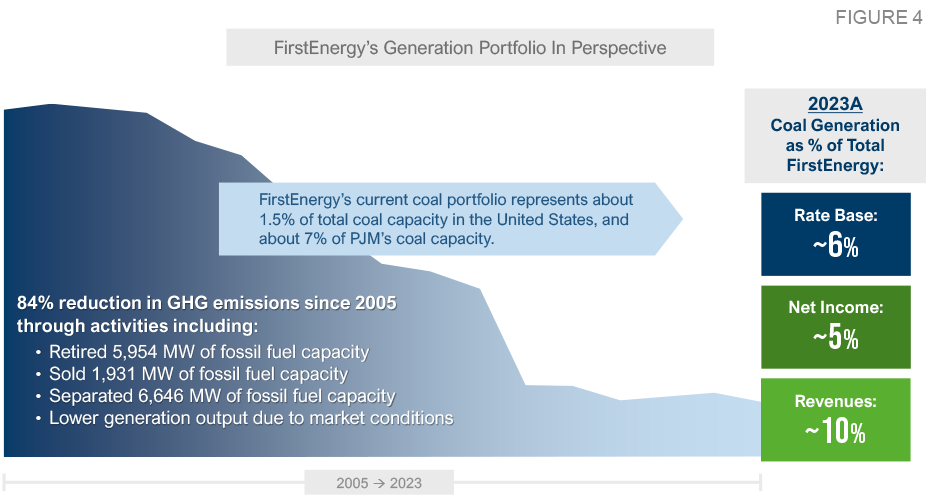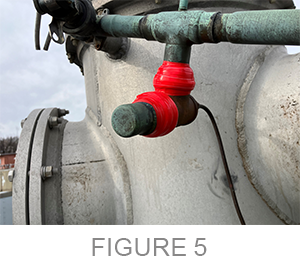CLIMATE POSITION AND STRATEGY
The world is transitioning towards a more sustainable energy landscape to reduce greenhouse gas (GHG) emissions and avoid negative physical impacts of climate change. FirstEnergy’s ability to support that wider effort, adapt, mitigate risks and capitalize on low-carbon opportunities is key to our long-term value and success. Investing in a resilient, flexible and technologically advanced grid, supporting the integration of diversified and renewable energy sources and reducing our carbon footprint are essential steps to enable the energy transition in our region and ensure our continued participation and growth in a changing energy market.
Understanding and preparing for potential physical impacts from climate change is also an important part of reliably enabling a low-carbon future. As an electric utility, we recognize that the changes in weather patterns that climate change can bring impact our operations, infrastructure, service reliability, customers’ experience and our company’s future success.
Serving over 6 million customers across states with varied climate-related challenges, economic conditions and regulatory environments, FirstEnergy is committed to doing its part to help ensure a bright future for our customers, employees, communities and the environment. With a keen understanding of our industry and customers’ needs, our leaders are engaging at the national and local levels to protect our communities and illuminate the path to a stronger, more electrified future. They’re also engaging internally on climate matters through our strong governance and oversight practices.
Today, with the climate, our business, and our stakeholders in mind, our Climate Strategy is two-fold:
- Reduce our company’s Scope 1 GHG emissions and achieve carbon neutrality by 2050.
- Support broader GHG reductions in our region by helping to enable the energy transition to a low-carbon future.
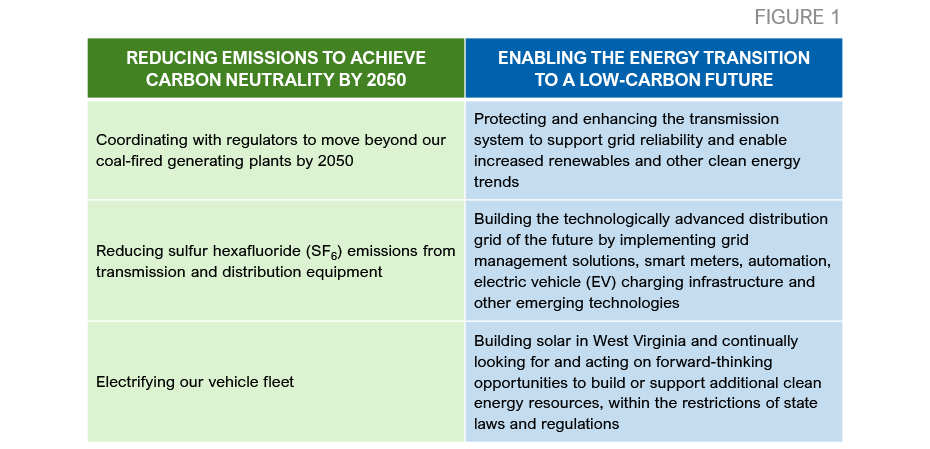
OUR GHG REDUCTION GOAL: CARBON NEUTRALITY BY 2050
FirstEnergy has a GHG reduction goal to achieve carbon neutrality by 2050.
What’s included: Scope 1 emissions, which for FirstEnergy consist of emissions from coal generation, SF6 leaks from transmission and distribution equipment and the company’s mobile fleet (mostly vehicles).
What’s excluded: Scope 2 emissions, which for FirstEnergy consist of emissions from transmission and distribution line losses and energy used to power our own facilities, and Scope 3 emissions, which comprise a range of upstream and downstream activities.
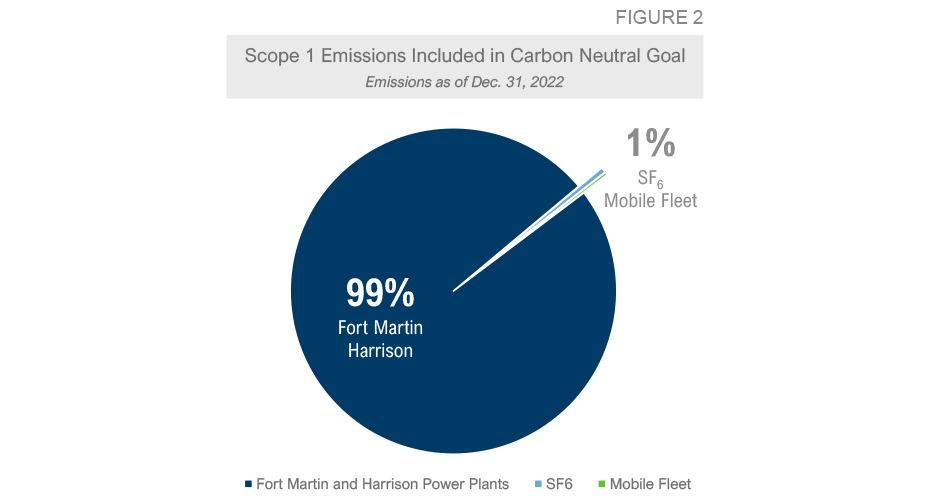
AFFIRMING OUR 2050 CARBON NEUTRAL GOAL; REMOVING OUR 2030 INTERIM GHG REDUCTION TARGET
After careful consideration and evaluation, in late 2023 we made the decision to remove our interim target to achieve a 30% reduction in GHG emissions by 2030 from a 2019 baseline since achieving it is not entirely within our control.
FirstEnergy’s core business is the transmission and distribution of electricity. However, emissions from our West Virginia regulated generating operations – consisting of two coal plants, Fort Martin and Harrison – serve as the main source of our Scope 1 emissions and greatly outnumber the emissions from our transmission and distribution operations. As such, our 2030 interim target was dependent on GHG reductions at Fort Martin and Harrison that could be realized only through a meaningful reduction in operation of these two plants prior to 2030.
Through our evaluation, we identified several challenges impeding our path to achieve the 2030 interim target:
- Energy Policy in West Virginia: West Virginia is heavily reliant on coal generation, from both an energy and economic perspective, and has established the energy policy and regulatory authority to sustain coal generation in the state. An intentional reduction in generating output for environmental reasons would not be prudent as it is inconsistent with the state’s energy policy.
- Resource Adequacy Concerns: In light of the significant retirements of base load generation scheduled through 2030, there is uncertainty about what resources will replace that generating capacity (see NERC and PJM reports).
- Changing Market Conditions: Energy market developments, including announced base load retirements from our PJM peers and changes in natural gas prices, have made it more economical than historically projected to run our coal plants.
In light of these challenges, we believe the most transparent course of action is to remove our 2030 interim target.
We remain committed to our ultimate goal of companywide carbon neutrality for Scope 1 emissions by 2050. While we have determined that we are unable to meaningfully reduce generation-based GHG emissions in West Virginia by 2030, we maintain our long-term commitment to move beyond our two coal-fired generating plants no later than 2050. In the near-term, we will monitor and evaluate emerging technologies or solutions that could reduce GHG emissions from these plants. We also continue our focus on GHG reduction in our transmission and distribution businesses. These emissions are within our control, pervasive in every state across our footprint, and aligned with our long-term, forward-looking transmission and distribution strategy to enable the energy transition.
GENERATION: JOURNEY TO CARBON NEUTRALITY
We are committed to working with our regulators to move beyond our two West Virginia coal-fired generating plants by 2050. Through various filings with the West Virginia Public Service Commission (WVPSC), we have identified that the end of useful life date is 2035 for Fort Martin and 2040 for Harrison. These dates are based on our assessment of when it is projected to no longer be cost effective and beneficial to customers to make the capital investments needed to keep these facilities operating effectively and in compliance with evolving environmental regulations.
In 2025, FirstEnergy will submit an Integrated Resource Plan (IRP) to the WVPSC that will include our analysis of market conditions and identify how we believe we can best fulfill our obligation to supply our West Virginia generation customers with reliable and cost-effective energy through 2040 (a requirement every five years in the state of West Virginia). This will be one important step toward understanding our evolving path forward to carbon neutrality.
We understand that the state of West Virginia strongly prefers asset-backed generation from its utilities, which means FirstEnergy will likely be expected to replace the energy from Fort Martin and Harrison. What resources that will entail and what our path to carbon neutrality will look like are uncertain at this time for a number of reasons – among them, potential environmental regulation relevant to power plants, future technological advancements in carbon-free resources, and resource adequacy concerns about capacity gaps amidst the closure of base load fossil fuel plants and the growth of intermittent renewable resources.
We will continue to follow the 5-year cadence of integrated resource planning in West Virginia and add increasing clarity about our pathway to 2050. And we will work closely with the WVPSC and the West Virginia Public Energy Authority (WVPEA) to develop our future generation transition plan, as the state of West Virginia requires their approval.
We also expect to eventually engage in a broad stakeholder dialogue to ensure a just transition for the West Virginia communities surrounding Fort Martin and Harrison as well as our own plant employees. FirstEnergy has a long history of transitioning fossil fuel plants. Since 2005, we have retired nearly 6,000 MW of fossil generation. Engaging communities, considering their unique needs and supporting the economic well-being of the surrounding areas were essential to our process in the past and will remain a priority in our approach to the future transition of Fort Martin and Harrison.
In the near term, we will continue advancing our goal of building solar in West Virginia and supporting the state in bolstering and diversifying the region’s energy mix by embracing solar to complement coal-fired generation.

Historical Generation-Based Carbon Reduction Achievements
Since 2005, FirstEnergy’s generation-based decarbonization efforts have resulted in substantial emissions reductions. As of December 31, 2023, these were achieved through a combination of efforts: retiring 5,954 MW of fossil fuel capacity, selling 1,931 MW of fossil fuel capacity, separating 6,587 MW of fossil generation and reducing generation output.
It’s important to note that selling or separating fossil fuel-based generation can reduce the company’s emissions, but it does not always reduce or eliminate those emissions for the planet – which is the primary objective of GHG reduction. We understand that all the coal generation we previously sold and separated from has since been retired.
FirstEnergy’s current coal generation fleet consists of two remaining plants (3,100 MW). As of December 31, 2023, it represents approximately 6% of the overall rate base and 5% of net income, and it comprises just 1.5% of total U.S.-based coal capacity and 7% of coal capacity in the PJM region.
Renewable Generation Strategy
Because we are primarily a transmission and distribution company, FirstEnergy’s role in the energy transition is not characterized by converting a large fossil fuel generating fleet to a renewable-based one – which is the focus of many of our industry peers. Instead, we’re focused on making the transmission and distribution investments needed to reliably enable and support low-carbon solutions in both generation and customer end use.
In fact, four of the five states in which FirstEnergy principally operates (Ohio, Pennsylvania, New Jersey and Maryland) are deregulated states that prohibit utilities from owning generation. This includes renewable sources such as solar and wind as well as energy storage when storage is defined as a generation asset.
Working within the bounds of state laws and regulations, we are continually looking for and acting on opportunities to build or support clean energy.
For instance, we’re advancing our goal to own at least 50 MW of solar generation in West Virginia by 2025. The first of five planned solar sites is now complete at the Fort Martin Power Station.
In addition, we’re leveraging our transmission and distribution expertise to connect renewable resources to the grid – in smaller scale ways like individual customer connections and larger scale ways such as connecting offshore wind to the grid in New Jersey or facilitating the incorporation of new renewable sources and accommodating increased demand across multiple states in the PJM region.
Please see our Investing in Renewables page for more detailed information about FirstEnergy’s renewables strategy and larger role in the energy transition to a low-carbon future.
SF6 EMISSIONS: JOURNEY TO CARBON NEUTRALITY
Sulfur hexafluoride, or SF6, is an inert gas commonly used by energy companies as an electrical insulating material and arc extinguisher in high-voltage circuit breakers and switchgear. If escaped to the atmosphere, it acts as a potent GHG with a global warming potential significantly greater than CO2.
Because of our companywide Scope 1 GHG reduction approach, reducing SF6 emissions from our transmission and distribution equipment is a key part of working toward carbon neutrality. Toward that end, FirstEnergy employs a multi-pronged approach, including:
- Leveraging quarterly leak rate analytics to identify SF6 leaks.
- Utilizing gas imaging technology in the field to pinpoint the exact source of individual SF6 leaks and inform how we resolve the leak.
- Enhancing the efficiency of our process from leak identification to leak resolution through improved education/training as well as enhanced repair, replace, and leak mitigation practices.
- Replacing circuit breakers with obsolete SF6 designs with newer models that have reduced nameplate capacity and improved gasketing materials.
- Establishing a cross-functional team dedicated to evaluating near-term non-SF6 alternatives for lower voltages and developing a longer-term vision for alternatives at higher voltages.
FirstEnergy’s efforts to reduce emissions from SF6 gas common in utility equipment are long-standing. Since 2011, FirstEnergy has reduced these emissions by approximately 75%. We continue to enhance our SF6 reduction strategy as we work toward carbon neutrality.
New SF6 Leak Mitigation Technique
FirstEnergy partnered with the Electric Power Research Institute (EPRI) in 2023 to pilot a new innovative tape mitigation measure for sealing SF6 leaks from utility infrastructure. The first-of-its-kind pilot took place in Morristown, New Jersey and involved carefully sealing an SF6 leak from a 230 kV gas-insulated bus with compression tape. The mitigation tactic can help FirstEnergy – and potentially other electric utilities – to mitigate certain SF6 leaks in the field going forward.
MOBILE FLEET EMISSIONS: JOURNEY TO CARBON NEUTRALITY
The largest source of emission from FirstEnergy’s mobile fleet is company vehicles. We are electrifying our vehicle fleet as part of our efforts to reduce Scope 1 emissions companywide and work toward carbon neutrality. By steadily and responsibly converting our conventional fuel vehicles to electric and plug-in hybrid alternatives, we expect to achieve our goal of electrifying 30% of our light-duty and aerial truck fleets by 2030 and 100% by 2050. As of June 2023, we have reached 10% electrification of this 3,400-vehicle combined fleet. The ability of vehicle manufacturers to build and deliver electric and plug-in hybrid alternatives is a risk to this strategy.
It is our intention to also electrify our medium- and heavy-duty fleets and set corresponding electrification goals for those classes in the future. We are regularly engaged with vehicle manufacturers on their progress to develop cost-effective electric solutions for those weight classes that suit the terrain in our region.
Beyond fleet electrification, we are also in the process of building our anti-idling efforts. Vehicle idling produces GHG emissions, so we see the potential for GHG reduction as well as fuel and maintenance cost savings through an anti-idling focus. Our near-term objectives in this area are idling data development, anti-idling policy refinement, and field education and engagement.
SCOPE 2 EMISSIONS
What are they?
FirstEnergy has two sources of Scope 2 emissions: transmission and distribution line losses and energy we use to power our company’s facilities/operations.
What are FirstEnergy’s current reduction efforts and potential future opportunities?
Although not an explicit part of FirstEnergy’s 2050 carbon neutral target, we are engaged in reduction efforts that impact Scope 2 emissions. As a primarily transmission and distribution utility, we plan to invest over $4 billion annually to strengthen and modernize our infrastructure. These investments improve the efficiency of our system and, in turn, contribute to the reduction of emissions from line loss. As we continue to focus on enhancing our transmission and distribution systems to enable the energy transition, we will also enhance our line loss reduction efforts.
In terms of facility energy use, we are rightsizing and optimizing office space at our facilities while preparing for expansions and additional facility needs in our transmission and distribution businesses to support the energy transition. We also incorporate energy efficient products and equipment – such as upgraded HVAC equipment, enhanced roof insulation and LED lights – where cost-effective and prudent. Additionally, we are ensuring new builds are equipped with the infrastructure needed to support a menu of sustainable options – from efficient HVAC systems to EV fleet charging and solar integration.
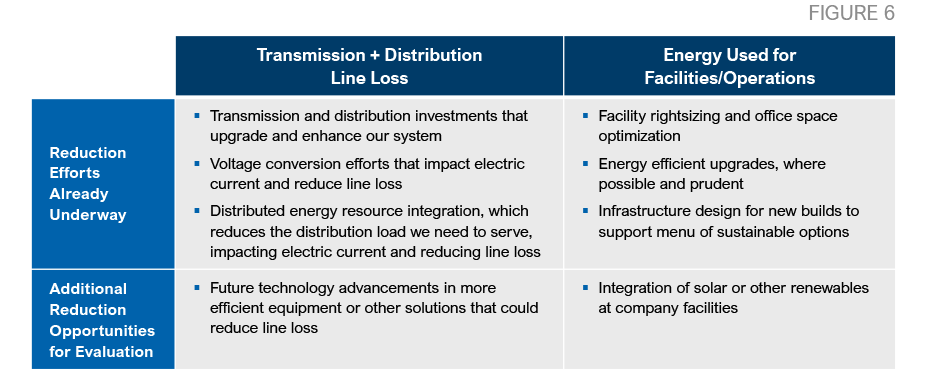
What are FirstEnergy’s Scope 2 reduction challenges?
There are some challenges to reducing Scope 2 emissions.
First, these emissions are partially based on the emissions intensity of the PJM region – which is outside FirstEnergy’s control.
They are also partially based on energy usage. And while we continue to focus on energy efficiency at our facilities, we face several energy use-related challenges, as well. For example, anticipated future load increases from EV fleet charging at our facilities and new transmission or distribution facilities could offset reductions achieved through facility closures, office space optimization efforts and other energy efficient practices. Additionally, some of our existing infrastructure is not capable of supporting energy efficient or sustainable upgrades, and retrofits can be cost prohibitive.
In terms of line loss, we face similar challenges. As we work to support the energy transition to a low-carbon future, we’re doing things like expanding transmission to accommodate more distributed renewables and making investments to enable end-use electrification. Both will increase line losses. So, as we support emissions reductions in our region through our transmission and distribution efforts, our own Scope 2 emissions from line loss could increase.
Will FirstEnergy set a Scope 2 goal?
We are carefully evaluating the impact of our current Scope 2 reduction efforts, assessing challenges, and considering additional reduction opportunities. This evaluation and our participation in EPRI’s SMARTargets initiative will help us assess whether we can set meaningful and achievable Scope 2 targets.
Refreshed GHG Inventory Management Plan
In 2023, FirstEnergy refreshed its GHG Inventory Management Plan in consultation with an experienced third-party consultant. This refresh included, among other things, enhancing our emissions calculation methods, improving data collection and management methods across all scopes, and calculating and evaluating Scope 3 emissions to determine relevance.
SCOPE 3 EMISSIONS
What are they?
Scope 3 emissions are indirect emissions comprised of 15 upstream and downstream value chain categories. In 2023, FirstEnergy leveraged a third-party consultant to calculate its Scope 3 emissions and determine which categories are relevant to our business. Our relevant Scope 3 emissions were determined to be: fuel- and energy-related activities (meaning purchased power resold to non-shopping customers), supply chain-related purchased goods and services and capital goods. Fuel- and energy-related activities were determined to be the largest, comprising 94% of Scope 3 emissions.
What are FirstEnergy’s current reduction efforts and potential future opportunities?
FirstEnergy has implemented relevant efforts that are expected to result, albeit minimally right now, in the reduction of our Scope 3 emissions. Those include:
Energy Efficiency Programs
Many of FirstEnergy’s utility companies help customers understand and use energy more efficiently and wisely through energy efficiency education. Between 2021 and 2025, we aim to help customers achieve cumulative reductions in electricity usage exceeding 7.5 million MWh and lower their demand on the electric grid during peak usage hours by 400 MW. Visit our Energy Management and Efficiency page for more detailed information.
Renewable Power Purchase Agreements (PPA)
Where cost-effective for our non-shopping customers (including the least-able financially), we assess opportunities for including renewable PPAs in our default service plans. For instance, we recently included a solar PPA for our non-shopping customers in Pennsylvania.
Supporting Renewables Integration
While we are prohibited by regulation from owning generation in four of the five states we principally operate in, we are leveraging our transmission and distribution expertise to enable and connect renewable resources in the PJM region. Some examples include:
- NJ Wind Interconnection: JCP&L Selected to Connect Offshore Wind-Generated Electricity to the Grid (firstenergycorp.com)
- Renewables Integration and Demand Growth in PJM Region: FirstEnergy Subsidiaries Awarded More Than $800 Million in Transmission Upgrades (firstenergycorp.com)
- Connection of Pennsylvania Solar Farms: West Penn Power Connecting Two Solar Projects to Electric Grid (firstenergycorp.com)
What are FirstEnergy’s Scope 3 reduction challenges?
Scope 3 fuel- and energy-related activities are based on two factors: customer usage and the emissions intensity of the power we purchase from the PJM market to serve our non-shopping customers. The challenge for FirstEnergy is that these two factors are largely outside of our control.
In terms of customer usage, we offer and encourage energy efficiency opportunities for customers, but we expect significant load growth increases from end-use electrification in the years ahead – and we welcome and encourage that electrification as part of the much-needed decarbonization of the economy.
In terms of purchased power, the emissions intensity of the PJM market is outside of FirstEnergy’s ability to control. For instance, if the energy mix in the PJM market evolves in the coming decades and transitions to cleaner energy resources, our Scope 3 emissions are projected to decrease in alignment with a lower PJM emissions intensity.
Alternative scenarios are also possible. End-use electrification could accelerate faster than predicted and result in a different trajectory for FirstEnergy’s Scope 3 emissions – one where our Scope 3 emissions don’t decrease as much or as quickly. Additionally, with growing reliability concerns about the transition from base load fossil fuel plants to intermittent renewable resources, it’s possible the clean energy transition in the PJM region slows and sets FirstEnergy’s Scope 3 emissions on another alternative trajectory.
Will FirstEnergy set a Scope 3 goal?
We view our ability to intervene or take actions that result in meaningful emission reductions as a key factor in goal setting. Right now, we do not see value or meaning in setting a Scope 3 GHG reduction goal because FirstEnergy has little reasonable ability (particularly while being mindful of cost impact to non-shopping customers) to impact its largest Scope 3 category: fuel- and energy-related activities. Any goal setting in this area would be based on variable external conditions rather than concrete actions that we believe we can take.
We will continue to track our relevant Scope 3 emissions as well as participate in EPRI’s SMARTargets program to determine if setting a Scope 3 GHG reduction goal can be done in a meaningful and achievable way for FirstEnergy in the future.
EPRI’s SMARTargets Initiative
FirstEnergy is participating in EPRI’s SMARTargets project – a two-year research initiative designed to develop a methodology for setting actionable GHG emissions targets at the company level that are grounded in science and aligned with global goals.
CLIMATE RISK AND THE ENERGY TRANSITION TO A LOW-CARBON FUTURE
Reducing GHG emissions is just one part of FirstEnergy’s Climate Strategy. The other major component is helping to enable the energy transition to a low-carbon future. This is also a strategic corporate objective for our company.
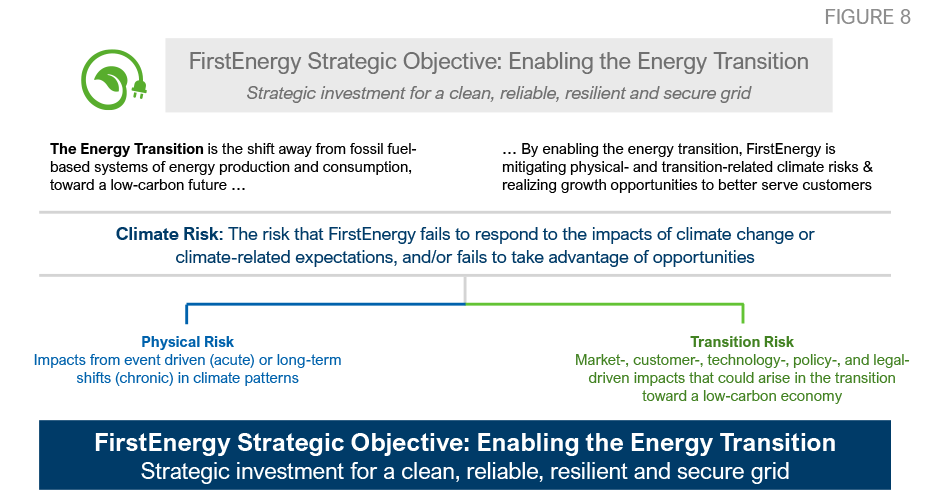
The energy transition is an economywide effort to decrease greenhouse gases and mitigate temperature rise to avoid negative physical impacts of climate change. The “transition” is one from fossil fuels to alternative low-carbon solutions in both generation (supply side) and customer end use (demand side).
As a regulated utility focused on transmission and distribution, we are the highway system between those two supply and demand bookends, and our role is to support and reliably enable that energy transition. That requires mitigating risks that could emerge – physical or transition – and capitalizing on opportunities well-suited to our customers, business model and a low-carbon future.
For more detailed information on FirstEnergy’s role in the energy transition, please visit our Grid Modernization and Investing in Renewables pages.
CLIMATE OVERSIGHT AND ACCOUNTABILITY
FirstEnergy's board of directors provides oversight and guidance on employee, environmental, social and governance (EESG) topics, including climate change. The board has five standing committees that, through their respective oversight responsibilities, assist in guiding FirstEnergy’s Climate Strategy and related efforts. The Governance, Corporate Responsibility and Political Oversight Committee (Governance Committee) has general responsibility for oversight of EESG matters and receives climate-related updates at each of its meetings. In coordination with the Governance Committee, the Operations and Safety Oversight Committee reviews and monitors environmental-related strategies, initiatives and policies, including in the area of climate change. The Finance, Audit and Compensation Committees also provide specific oversight of EESG matters that fall within the scope of responsibilities set forth in each of their charters. Please see the company's Climate Report for additional climate-related board oversight information.
The full board of directors also provides oversight of risk management practices, reviews material company risks – including the climate-related ones – and helps ensure processes are in place to support a strong risk management culture. In addition, the board’s Audit Committee:
- Oversees the enterprise risk management (ERM) program and process for identifying, assessing, managing and monitoring enterprise risks.
- Assures risks are appropriately communicated with the board and its committees.
- Oversees risks related to the specific Committee responsibilities, including risks related to financial statements, controls and reporting, as well as steps taken to monitor, control and mitigate such exposures.
- Reviews the risk management governance, guidelines, policies and procedures annually.
At the management level, responsibilities for climate matters are spread across the company. Cross-functional management-level committees – including the Corporate Responsibility Steering Committee, the Climate Subcommittee and the Enterprise Risk Management Committee – are designed to bring relevant leaders together to help FirstEnergy advance climate action in alignment with our corporate strategy, identify and manage climate risks, capitalize on energy transition opportunities, and provide transparency through disclosure efforts. Visit our Climate Report for more information on these management-level committees.
Climate risks are integrated into our ERM process much like any other enterprise risk. FirstEnergy’s current material risks, including those related to climate, are identified and discussed in our annual and periodic reports. To read more about FirstEnergy’s risk management oversight and the ERM program and process, including the integration of climate risks, please see the Enterprise Risk Management page and our Climate Report.
Our Climate Report also includes insights from low-carbon (~1.5-degree) and high-carbon (~4.5-degree) scenarios. These additional scenarios, which build upon the 2-degree analysis we conducted in 2019, help us to view a broader range of possible climate futures and understand some of the potential long-term climate-related risks and opportunities associated with each. The report was designed according to the Task Force on Climate-related Financial Disclosure’s (TCFD) climate risk framework. Please see our TCFD Disclosure to locate our responses to their leading guidance.

